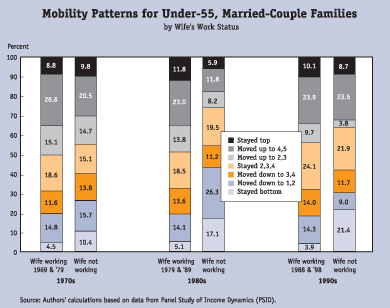Wives' Work and Family Income Mobility 
Motivation for the Research
Over the past 30 years, married women in the United States have significantly increased their labor market participation, annual hours, and cumulative lifetime labor market experience, and have moved into higher wage occupations. The extent of this transformation of historical patterns indicates that women have become an increasingly integral factor in their families' ongoing economic well-being.
The transformation raises questions about the economic impact of having two-earner families become the norm. Do American families now need two earners — a working husband and a working wife — to have any hope of getting ahead or to keep from falling behind? How much does a wife's labor market activity (participation, hours, and earnings) matter in her family's ability to make income gains, hold its place relative to other families, or avoid losing ground?
Research Approach
The authors analyze data from the Panel Study of Income Dynamics (PSID), which has followed 5,000 American families, including their offspring families, since 1968. Information is extracted on total family income; work hours and earnings of head and spouse; age and presence of children; and other characteristics. Each family is observed at the start of one of three periods (1969, 1979, and 1988) and ten years later.
Families are ranked according to the ratio of their family income to the PSID's measure of needs, an indicator that reflects economies of scale for people living together, and classified into quintiles at the beginning and end of each decade. Family income mobility is defined as movement from one quintile to another during a decade and is quantified in a five-by-five matrix that reports the percentage of families in each beginning-of-decade quintile who end in each end-of-decade quintile.
The paper focuses on married-couple families in which both partners are under age 55 and compares the mobility outcomes of those with and without a working wife, with and without children and a working wife, or in which the wife has attained various levels of education. It also compares the average work hours and earnings of husbands and wives across mobility-outcome categories. These comparisons are aimed at highlighting the degree to which favorable mobility outcomes are (or are not) associated with greater wives' labor market activity.
The chart below summarizes the information from the 25 cells of the mobility matrix
into seven mobility-outcome categories, separating families with and without a working wife.
Key Findings
- While a working wife was not necessary for a family to move ahead, having one definitely helped: Wives in families that moved ahead or maintained their position had high and rising employment rates, work hours, and pay.
- The annual earnings of wives in upwardly mobile families increased relative to those of their husbands in all three periods, while in downwardly mobile families wives' labor earnings decreased as wives' employment rates and hours of work rose by only small amounts (or fell), and hourly pay dropped.
- Nevertheless, almost one-fifth of families with a working wife were stuck at the bottom or moved down into the poorest or second-poorest quintile, while one-sixth to one-third of those without a working wife stayed in the richest quintile or moved up to the richest or next-to-richest quintile.
- The popular perception that families needed to work more hours to get ahead or hold their own is confirmed. Total family (husband+wife) work hours rose markedly over the three decades, with most of the increase coming from wives.
- Increases in work hours were especially pronounced for families with children. Families with children who held their own relative to other families increased their work hours substantially, and some families with children who lost ground did so despite added work hours.
- B oth more-educated and less-educated wives expanded their earnings and thereby contributed to their families' gains, although for more-educated wives the effect of this change on family income was surpassed by an even greater increase in husbands' earnings.
Implications
Married couples accounted for over half of all U.S. households in 2000, and the ability of wives to engage in the paid labor force, increase their work hours, and earn reasonable pay is integral to their families' economic prospects.
By uncovering associations between wives' labor market involvement and married-couple families' moves up and down the income-to-needs distribution, this study can usefully inform discussions about government and private-sector policies on a range of issues related to women's work and family support. These might include income redistribution, tax policy, family leave and child care policies, employers' approaches to work flexibility and work-family balance, and efforts to increase investment in education.


 About the Authors
About the Authors
Katharine Bradbury
Jane Katz



